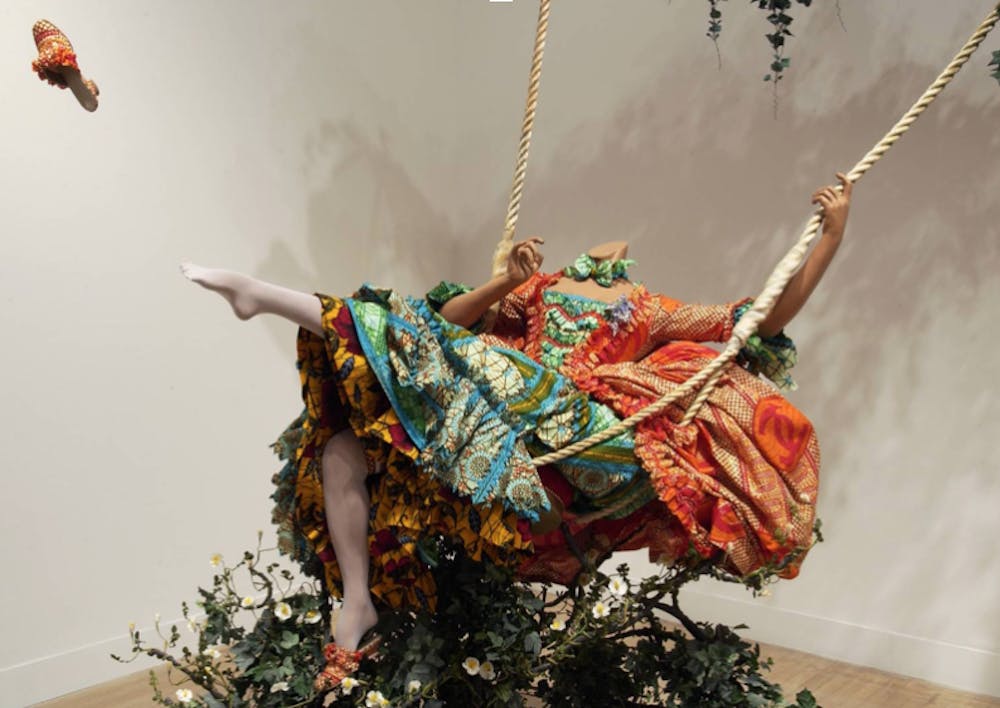Jean–Honoré Fragonard’s “The Swing” is a vision straight out of a dream. A woman, almost subsumed by her billowing gown, playfully swings in and out of a lush, enchanted garden as a man cheekily watches her from below. Her shoe flies through the air as a symbol of the carefree, facetious lifestyle she lives as a member of the 18th–century French bourgeoisie. Her haute life is characterized by opulence and excess, and her coquettish giggles are almost audible through the canvas. Yet, while real women like Fragonard’s fictionalized subject enjoyed nonchalant and playful afternoons, outside of their frivolous bubble the world was not such a dream–like place.
Nearly 250 years later, Yinka Shonibare articulated this paradox in his 3–dimensional installation titled “The Swing (After Fragonard)." Using the original painting as a jumping–off point, Shonibare exposes the hypocrisy within Fragonard’s piece to communicate multiple social critiques. While Shonibare’s woman sits familiarly on the swing while her shoe stays suspended in the air, she now wears African print fabric and has chestnut colored skin. This choice provides a stark contrast to the original piece: Shonibare has inserted a woman of color into the Rococo tradition, an artistic movement during a time period that exploited and dehumanized her.
The horrors of the Middle Passage, famine among France’s lower class, and colonialism, while they seem universes apart from Fragonard’s joyful scene, were unfortunately more closely intertwined than expected. Brushing these intensely violent and brutal social dilemmas under the rug, European elites selfishly carried on their exploits while offensively basking in excess, as seen in extravagant fashion, embellished architecture, and many other aspects of life. This demonstrates the great paradox of the Rococo period: Louis XIV partied at Versailles after a long day of authorizing colonialist exploits that relegated millions to an insufferable life where such parties were unimaginable.

Aside from the racial connotations, viewers will find many more details and interpretations to muse over in Shonibare’s installation. For example, likely referencing the guillotine that beheaded the disloyal French aristocracy during the Revolution, Shonibare chose to make the woman headless. Other choices like the exclusion of the voyeuristic man reveal deeper and meaningful aspects of analysis prevalent in the piece.
Shonibare’s work is inspirational for reasons that span far beyond his mastery of artistic technique. He uses the framework laid out by a historical piece that was likely the talk of an aristocrat’s extravagant luncheon to make a provocative and critical claim about the ignorant and egocentric life those very aristocrats lived. Paraphrasing Fragonard’s representation of carefree luxury, Shonibare sheds light on the people leading far less glamorous lives during this time. Specifically, Black people who were ripped from their homes and enslaved based on instructions from people like those portrayed in Fragonard’s original piece.
Shonibare’s transformation of “The Swing” functions broadly as a social commentary relevant even today. By reappropriating the culture of the oppressor to create something that meaningfully represents the past from the perspective of the oppressed, he encourages society to change the way history is understood. His provocative choices prompt viewers to rethink biases, thought processes, and historical narratives.
Racism still rears its ugly head more often than many would like to acknowledge. Art—whether avant–garde or traditional—can be an effective means of radical change and set the stage for global shifts. In the instance of “The Swing (After Fragonard),” Shonibare uses historical context to spark critical thought and rouse emotion.







